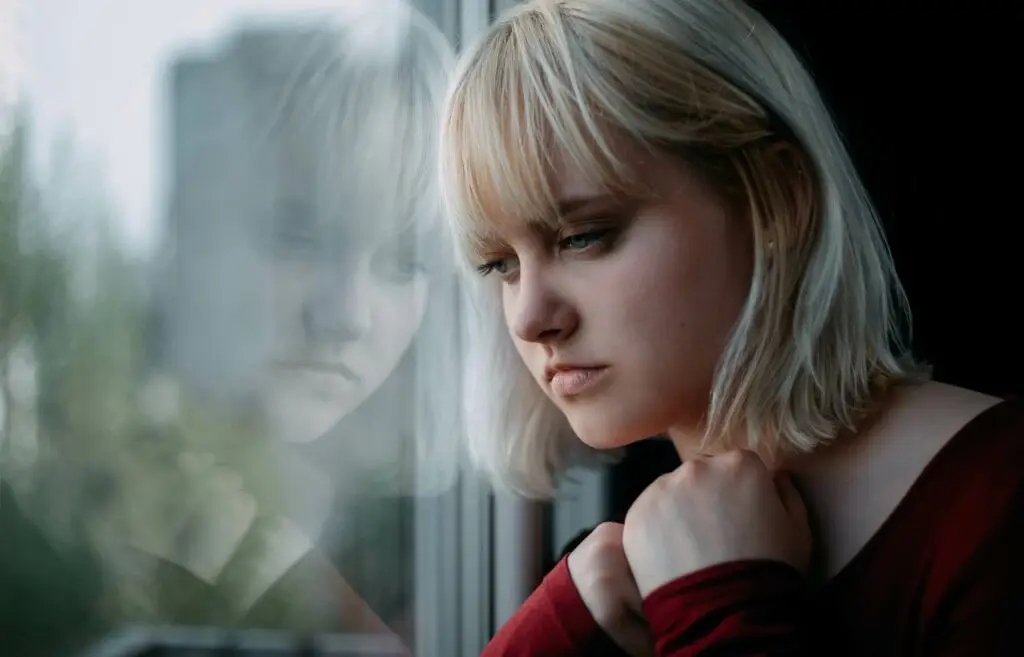Are you stuck replaying an event from the past repeatedly in your head?
Have you stopped trying to improve your life circumstances because you think, “What’s the point? Things will never change.”?
Is it difficult to challenge unhealthy self-talk because you believe the harmful words and actions people have said or done to you in the past?
These are all examples of depressive thoughts. Depression can be a lonely and confusing place. It can leave you feeling stuck, like nothing will ever change, and lose hope for the future.
Did you know that if you are depressed, you may be living in the past?
What does “living in the past mean,” and how can this way of thinking affect your life?
In this blog post, we’ll dissect what it means to be “living in the past,” how it perpetually holds you back from your potential, and how to start living in the present to find peace and joy in life.
If you are depressed you may be living in the past.
To conquer your thought patterns, it’s helpful to understand the root cause of your beliefs. Knowing the root cause of your thoughts is necessary for any effort you put into this process to be more effective. If you are experiencing depressive thoughts, loss of motivation, loss of hope, or lack of interest in things you used to enjoy, speak to a Makin Wellness counselor for a proper evaluation and diagnosis.
Once you have a diagnosis, whether that is depression, anxiety, PTSD, or any combination of diagnoses, your therapist will help you create a personalized plan to help you work through your thoughts and experiences to relieve these feelings.
Why is a mental health evaluation or diagnosis necessary?
Mental health can be complex, highly individual, and sometimes unpredictable. One day, you may feel like you can get things done and feel good; the next, you might feel like you’re in a pit of despair and find it challenging to pull yourself out of. Having an evaluation and, if necessary, a diagnosis can help ensure you get the level of help you need to be safe and feel supported.
Are you living in the past?
For many, living in the past is not a conscious choice. It is a habit that feeds off negative experiences, regrets, what-ifs, and consistent mental programming you experienced from the words or actions of others.
Examples of living in the past may include:
- Replaying unpleasant scenes: Replaying the same harsh scenes of failure, rejection, or loss further reinforces your negative self-beliefs.
- Reliving moments that define you: Past traumas can render the present moment hostage. Your mind and body are re-experiencing the identity formed in those painful events as you relive it in your mind. This also reinforces unhealthy self-beliefs and a pessimistic worldview.
In both scenarios, the past is a reminder of what is comfortable for you to believe – even though these thoughts are harmful, they are still considered your “comfort zone.” Each time you replay or relive these experiences how they were initially felt and internalized, you reinforce the distorted perceptions you may have about yourself and the world around you.
Examples of negative distortions in self-beliefs and worldview include:
- No one can be trusted.
- I am unlovable.
- I always fail and never get anywhere in life.
- No one will ever believe in me.
- People will always let me down.
If you have experienced trauma or difficult times in your past, it is entirely normal to have these thoughts and feelings. When people treat you poorly, it seems logical that you must be the cause of the issue. It can be easy to feel that these thoughts are the only ones that could be true. Just because it is easy to think this way doesn’t mean it is true.
Next, let’s uncover how being stuck in the past can affect your present and future life.

How living in the past holds you back
Living in the past deprives you of the vitality of the present and, consequently, the seeds of future joy. Let’s understand how this thinking can hold you back from positive experiences and accomplishing big life goals.
What does living in the past do to your life?
- Saps your energy: The mental gymnastics required to loop around old memories is a taxing exercise, leaving you depleted of the energy that could be spent in the present.
- Stifles personal growth: When the past weighs down on your present, it becomes nearly impossible to take those crucial steps towards healing, growth, and creating new, positive experiences.
- Filters out the good: When you live in the past, your mind can become fixated on the negative and overlook all that is good in your life. This can lead to a distorted perception of reality where you cannot see or appreciate positive experiences and relationships.
- Limits your potential: Living in the past limits your potential for growth, success, and happiness. Constantly replaying negative experiences and thoughts makes it difficult for you to see a bright future for yourself.
Recognizing the weight of your memories is a crucial step in unloading them and beginning to walk a little lighter each day. Next, let’s discuss what it looks like to live in the present.

What does living in the present feel like?
Contrary to popular belief, the present moment is not a pause between the past and the future – it is its own place entirely. Each moment you are present for is its own space to experience life outside of the past or future.
Living in the present includes:
- Mindfulness and observation: To be present is to observe your feelings and surroundings without judgment, fear, or attachment.
- Engaging with life: Fully slipping into the flow of life—enjoying a quiet cup of coffee or immersing yourself in a favorite activity without the past casting its shadow—is crucial.
- Savoring experiences: Recognizing and being grateful for the good in your life is essential in living in the present. It can be as simple as appreciating a beautiful sunset or savoring a delicious meal.
- Creating and chasing dreams: When you live in the present, you can let go of negative thoughts holding back your potential and work towards creating a brighter future.
Living in the present – sometimes said as living in the moment – means not rooting yourself too far in the past, holding on to old ideas or identities, and not too far in the future, which can cause anxiety and worry.

Release the Past
So, how do you break away from living in the past?
This goal requires consistent effort and self-awareness. Part of this process will be done with your therapist to deeply work through past experiences in a safe place where big feelings and reactions to complex thoughts may occur.
In addition to working with your Makin Wellness therapist, you can take steps at home to further support your change of self-beliefs and efforts to live in the present.
How to start living in the present:
- Pay attention to your thoughts: Practice mindfulness and become more aware of your thoughts and feelings. When you catch yourself dwelling on the past, acknowledge it and consciously shift your focus to the present moment. This does not dismiss your thoughts or the past. Rather, it affirms that you are in a different place than your memories and encourages you to remember who and where you are now.
- Focus on the now: Engage in activities that bring you joy or plan something fun to do in the future. This helps break away from illogical thought patterns and helps create new, positive thoughts, feelings, and memories.
- Practice forgiveness: Forgiving others and yourself can help you release negative emotions and move forward. This does not excuse trauma or the responsibility for actions that have caused you harm. It simply releases you from the pain of these memories.
- Challenge your beliefs: Question the unhealthy self-beliefs and thoughts that arise from the past. Are they entirely true? What evidence do you have to support them? Could the opposite be true? What would you tell someone else who has gone through what you have? This exercise can help break down illogical thought patterns and create a more balanced perspective.
- Just breathe: Take a big, deep breath. Know that you have inherent value, that you are worth more than your past experiences, and that it is the human experience to feel various feelings throughout life. Tell yourself that you are enough to experience peace, to let go of any illogical thoughts you have about yourself and that you can learn to see yourself in a positive light.
By taking these steps and actively working on releasing the past, you can start living in the present and create a better future for yourself. Remember that it is a journey, and there may be setbacks – progress is not linear. With persistence and self-compassion, you can overcome living in the past and find peace in the present.
The past may have shaped you until where you are right now. The past no longer needs to define you. Now, you can decide your thoughts, feelings, and beliefs about yourself.
Summary
The realization that depression often roots itself in a relentless cycle of reliving the past can be disheartening. Now you know that to step into the light of the present is both a choice and a possibility. This is not to downplay the gravity of depression or the complexities of mental health issues. Rather, it emphasizes that you have the power to shift your internal dialogue and release yourself from the chains of the past.
Are you ready to make a change? To step forward unburdened by the past? Take the first step toward living in the present and gain positive self-beliefs to help you live a more peaceful, happy life. Call us at (833)-274-heal or schedule an appointment with a Makin Wellness therapist today.







